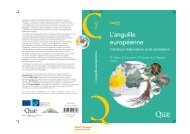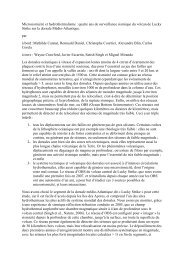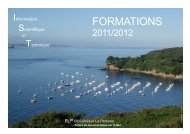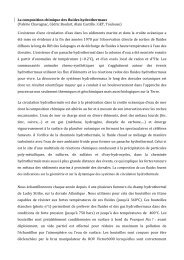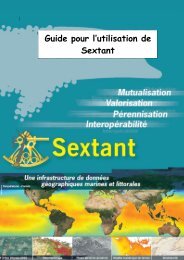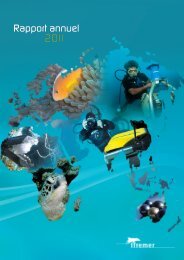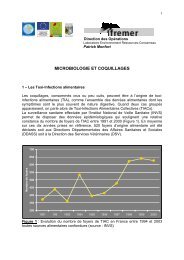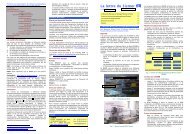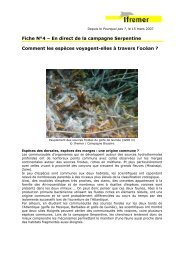2D image mosaic building 2D3 - Ifremer
2D image mosaic building 2D3 - Ifremer
2D image mosaic building 2D3 - Ifremer
You also want an ePaper? Increase the reach of your titles
YUMPU automatically turns print PDFs into web optimized ePapers that Google loves.
Time update equations (“predict”)<br />
x = A xˆ<br />
+ Bu<br />
− ˆk + 1<br />
−<br />
k +1<br />
k<br />
P = A P A + Q<br />
k<br />
k<br />
k<br />
T<br />
k<br />
k<br />
k<br />
Measurement update equations (“correct”)<br />
K<br />
x ˆ<br />
k<br />
k<br />
− T − T<br />
= P H ( H P H − R )<br />
k k k k k k<br />
−<br />
−<br />
= xˆ<br />
+ K ( z − H xˆ<br />
)<br />
k k k k k<br />
P I K H ) P<br />
−<br />
= ( −<br />
k<br />
k k k<br />
−1<br />
In these formulae, the variables stand for:<br />
Project Exocet/D page 13/16<br />
−<br />
• xˆ : A priori state vector at time k (given the process before step k)<br />
k<br />
• xˆ : A posteriori state vector at time k (given the measurement at time k)<br />
k<br />
• z : Measurement vector at time k<br />
k<br />
• u : Vector of the control entry<br />
k<br />
• A : Matrix linking the states at time k and k+1<br />
k<br />
• B : Matrix linking the control entry to the state vector<br />
• K : Kalman gain matrix<br />
k<br />
−<br />
• P : Matrix of covariance of the prediction error<br />
k<br />
• P : Matrix of covariance of the a posteriori error<br />
k<br />
• H : Matrix linking the state to the measurement<br />
k<br />
• w : Process noise, assumed to be white and gaussian<br />
k<br />
• v : Measurement noise, assumed to be white and gaussian<br />
k<br />
• R : Covariance matrix of the measurement noise<br />
k<br />
• Q : Covariance matrix of the process noise<br />
k<br />
In the case of video <strong>mosaic</strong>ing, the state variables are the positioning (X_utm and Y_utm)<br />
and a term to correct the pixel size. The measurement vector consists of X_utm and Y_utm<br />
given by navigation system.<br />
The experiment we have led is to perform a route with the underwater vehicle and to perform<br />
the same route in the other direction. We can notice in Figure 5 that there is a shift of the<br />
<strong>mosaic</strong> if we don’t use navigation in the algorithm whereas when using dead-reckoning<br />
navigation in the Kalman filter, the <strong>mosaic</strong> drift is well corrected.<br />
Deliverable N° <strong>2D</strong>3<br />
Report on <strong>image</strong> <strong>mosaic</strong> <strong>building</strong><br />
DOP/CM/SM/PRAO/06.224<br />
Grade : 1.0 27/09/2006




